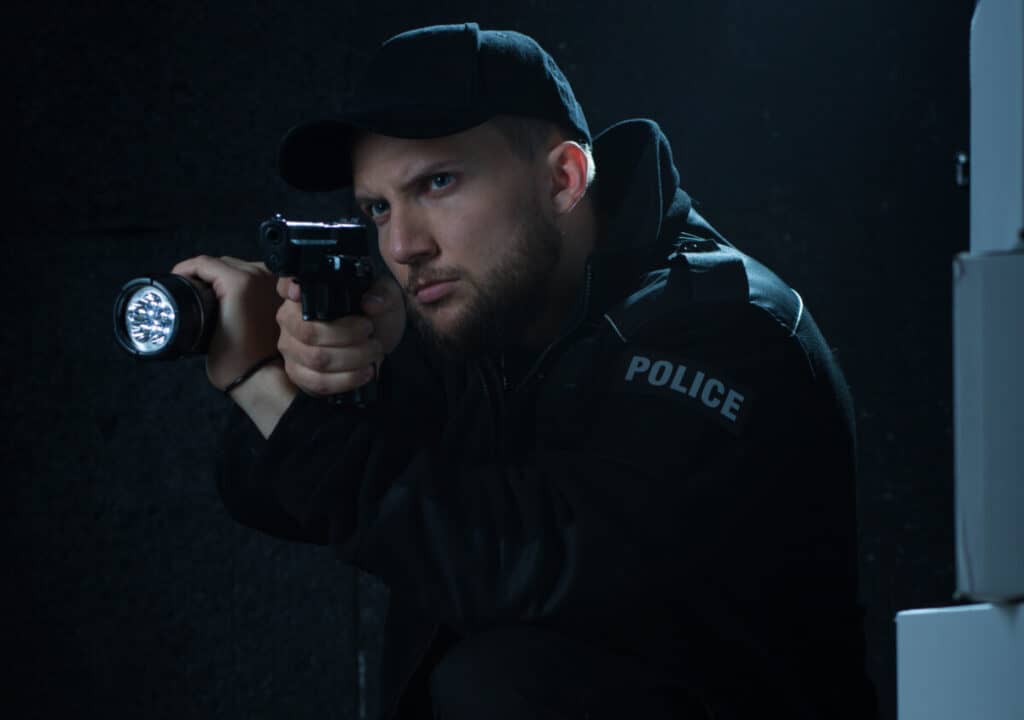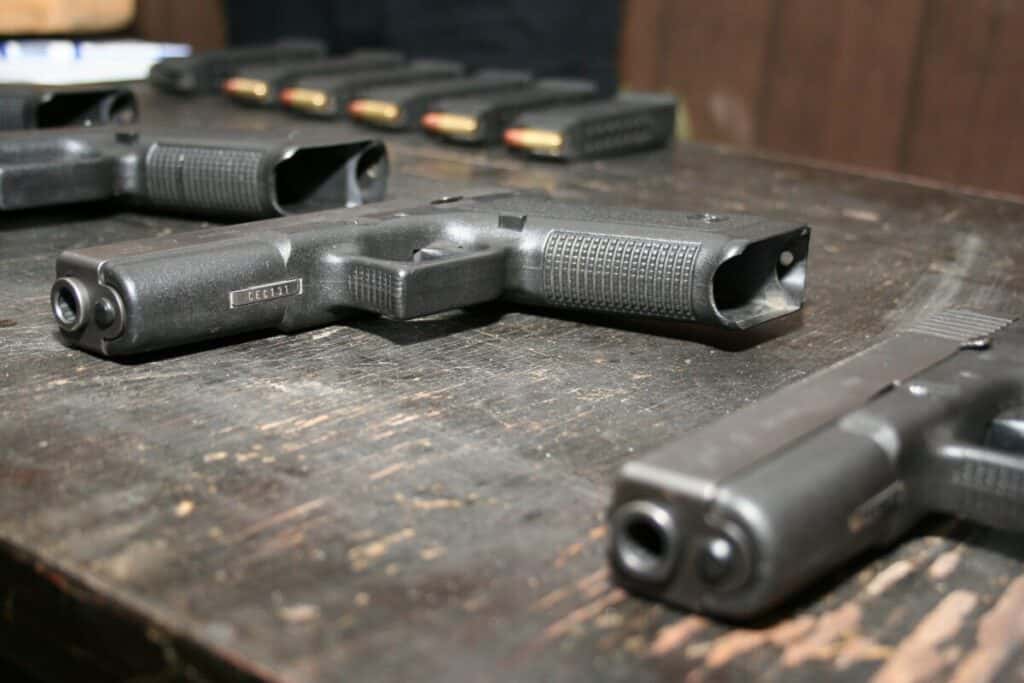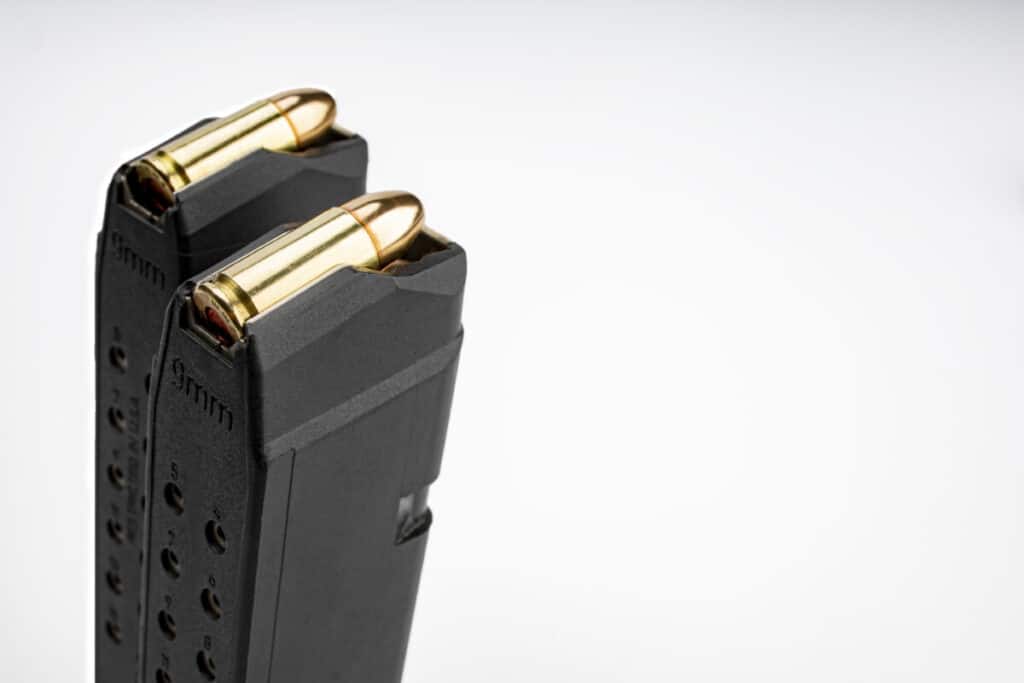Models & Brands of Handguns Used by Police Departments

The policeman and his sidearm are almost inseparable. Rarely will a law enforcement officer be without it, and certainly not while in uniform and in public. It is his first lethal force option, and while not the most effective, it is there at a moment’s notice.
65% of police departments in the USA use the Glock Model 17, or the Glock model 22. A smaller percentage have selected handguns from Smith & Wesson, Beretta, and Sig Sauer.
Modern pistols have reached a quality level that makes many of them suitable for a law enforcement role. With that said, departments gravitate toward a handful of common models. Some reasons are obvious, but one might surprise you.
Glock Dominates the Law Enforcement Market
At the state, county, and local level, no brand even comes close to the popularity of Glock pistols. Unless you are very unfamiliar with the topic of discussion, this should not surprise you.
Standard Disclaimer
I serve as a law enforcement officer at the municipal level, but everything I write in this article is my own opinion. My first goal is to stay true to the title of this article and give a birdseye view of popular sidearm models among law enforcement. But, along the way, I would like to add perspectives that might be less commonly understood by the shooting public.
In addition to being a police officer, I am also a competitive shooter and hold the rank of Master in both USPSA and IDPA. I have had the opportunity to see many shooters of all skill levels, including the shooting public, military, and law enforcement. I have also seen many makes and models of pistols being used by shooters of all skill levels.
Before I became a law enforcement officer, Glock entered the US market and cut a wide swath. They pushed aside revolvers and metal-framed double-action/single-action (DA/SA) pistols to become the new standard. While Gaston Glock didn’t invent the striker-fired pistol or the polymer-framed pistol, he certainly made them extremely popular.
The most common models are unsurprisingly the Glock 17 and 22.
These are chambered in 9mm Luger and 40 S&W respectively, and represent the full-size version for each cartridge. These are the one-size-fits-all type of pistols, carrying a lot of bullets but not being a burden in the weight or size department.
Compact models, such as the 19 and 23, have a following among both uniformed and plainclothes officers. Plainclothes officers don’t wear a Sam Browne style belt but aren’t overly concerned with concealing the fact that they are armed either.
While these models are technically “compact”, the size difference between them and the full-sized versions are fairly nominal.
It is much less common to see Glock models chambered in 45acp or the longer barreled competition models. Sometimes, officers who carry these models wish to subtly advertise that they view themselves as firearm enthusiasts. But, many departments simply don’t offer such extravagant levels of variety.
In law enforcement (and the military), people argue for greater levels of end-user choice and against it. Neither side is entirely right, nor entirely wrong. It is uncommon for a police officer to train to a level of proficiency where small differences in firearm features or models will impact their shooting skills.
The Other Options
Smith & Wesson has done very well for itself with the M&P line of pistols.
M&P stands for Military and Police, so it’s no secret what market these pistols are gunning for. This line of pistols is certainly aimed at (the last pun, I promise) regaining some of the market dominance the brand used to enjoy. It is no coincidence that, like Glock, they are both striker-fired and polymer-framed pistols. The M&P9 and M&P40 are the most popular models.
Some older officers still carry the Gen III pistol in departments that grandfather in the specific pistol an officer is first issued. These are metal framed, DA/SA pistols and are old enough that they are likely never issued to new officers. Smith & Wesson has discontinued this line of pistols and more recently has stopped supporting them with customer service.
Sig Sauer has long enjoyed the reputation of being the enthusiast’s pistol with their P226 model. Long associated with the Navy SEALS, these pistols carried a price premium which often priced them out of the law enforcement market. Along with the P229 and the SP2022, all of these models have suffered in popularity from the shift toward striker-fired pistols.
Sig Sauer has made a much more competitive effort to get back into the mainstream with the P320, and the Army’s adoption of the M17 is certainly going to help moving forward.
This model has also had some recent controversy, with its ability to discharge when dropped at a certain angle. Sig, to their credit, has modified the trigger to correct this problem. But the underlying issue, having zero externally disengaged safeties, remains.
It seems like an odd holdover from the laughably unpopular P250, which was a double-action-only (DAO) pistol and didn’t need an external safety.
Beretta is another brand that has lost much of its market share over the years. The Beretta 92 was, and still is, the most accepted Beretta pistol for law enforcement. But since the early 2000s, it has become increasingly uncommon to see officers issued a Beretta outside of the Maryland area, which is where Beretta USA is headquartered.
The common calibers are 9mm Luger and 40 S&W, with 45acp being less common. Specialty calibers like the 357 Sig and the 45 GAP are even less common, and with high recurring ammunition costs, this trend is sure to continue.
Striker-Fired Mania

A striker-fired pistol will generally have a 5-7 pound trigger pull for every shot, from the first, to the last.
Striker-fired pistols have dominated the modern law enforcement market for an entire generation. DA/SA pistols initially gained widespread acceptance in law enforcement at the dawn of the “Wonder 9” era, only to see a collapse in popularity compared to striker-fired pistols.
This is not because striker-fired pistols are necessarily better, but when time and money spent on firearms training is limited, yes, they are better. I personally carry a striker-fired pistol for duty and shoot a DA/SA pistol in competition, so I feel qualified to get up on my soapbox for a short while.
The issue I am going to preach about is a lack of confidence and competence in making effective use of the first two shots with DA/SA pistols.
What I hear and read online about user skill with DA/SA pistols, and what I see with my own eyes, are very different things. Reading gun forums, and speaking with gun owners in a non-shooting environment, would lead a person to believe that shooting the longer double-action trigger pull, and the subsequent double-to-single-action transition pull is a skill that many people possess.
It might not be a natural motion, but with effort, it is smoothly learned and one does not need to be a top-level shooter to grasp the idea.

A DA/SA pistol will have a longer and heavier first trigger pull as the hammer is cocked by pulling the trigger. Subsequent trigger pulls are short and light as the hammer is cocked when the gun fires
What I see in real life, both in competitive shooting, as well as in military and law enforcement training, is that few outside of the most dedicated shooters really learn it. I have seen people miss targets by several feet, or need up to three to four seconds of focus for an effective first shot.
I have also seen people completely stop their mental process prior to the second shot, sometimes to prepare for the different single-action trigger pull, but more often to factor in the missing of the first shot. After readjusting their grip, and refocusing on their sights, they are ready to pull the trigger again after a significant lapse in time.
I have also seen many people give up on the double-action trigger pull when the first shot matters, and thumb-cock the gun. In NRA Tactical Police Competitions (TPC) they have a rule that prohibits thumb-cocking. With a DA/SA pistol, the first shot must be taken in double-action.
If you don’t believe me, watch some Youtube gun reviews of DA/SA pistols from non-competitive shooters. The examples of reviewers demonstrating shooting in double action are few. Any difficult shot is taken in single action and any accuracy testing is done in a single action. When the reviewer hands the gun off to a newer shooter, it will literally never be shot in double action.
And this is one of the weaknesses of DA/SA pistols. Guns allow people to cheat and get better results. I have personally seen many inexperienced shooters focus solely on their strengths when practicing. On the other hand, switching to striker-fired pistols avoids this specific problem.
Holster Selection, the Hidden Consideration
I briefly feel the need to cover this less discussed factor in firearm selection. Most uniformed officers will use what is called a Level III holster. These holsters have locking features that prevent the gun from being drawn prior to them being disabled. They typically require two to three smooth motions from the officer to disengage but are very difficult to manipulate for a person standing in front of the officer.
The Glock 17 and 22 have more holster choices than I can count. Basketweave, high-gloss, drop and offset, meant to accommodate weapon lights, thigh rigs, all the choices are there. The Smith & Wesson M&P9 and M&P40 also have several options. The Smith & Wesson M&P40L (5-inch barreled version) has none.
This complete lack of selection for less common models means departments aren’t going to stray far off the beaten path when it comes to firearm selection.
9mm Luger, The Once and Future King.

These two magazines hold more cartridges than 80-million revolvers.
The age of the “Wonder 9” was when high-capacity semi-automatic pistols chambered in 9mm Luger proliferated the US market. Many nowadays will call them standard capacity guns, being that they were designed to hold 15-19 cartridges in a magazine, but compared to 6-shot revolvers their capacity is still quite high.
Law enforcement came to accept that more than doubling capacity along with a significantly quicker reload was beneficial and began phasing out revolvers.
An event that took much of the energy out of 9mm Luger adoption was in the infamous FBI Miami Shootout, which happened in 1986. The purpose of this article is not to rehash the shootout in great detail, but to say that the 9mm Luger became one of the scapegoats of a shootout that led to the death of two FBI agents with multiple others wounded.
One of the subjects killed in the shooting was mortally wounded after being shot by a 9mm bullet, but continued fighting and killed both agents. Many at the time felt that a more powerful cartridge would have stopped the threat much quicker.
After the shootout, the 9mm seemed to teeter between being viewed as either barely adequate or barely inadequate.
This ushered in the age of the 40 S&W. While not a direct change-over, as the 40 S&W was introduced in 1990, it rather evolved as a toned-down version of the 10mm Auto.
The 10mm Auto was never going to be an acceptable law enforcement cartridge, as it was too powerful for newer or smaller framed shooters. By the time loads were developed which significantly underperformed what the 10mm Auto was capable of, the case was shortened to fit in a 9mm Luger frame, and the 40 S&W (Short and Weak) was born.
It has been my experience that a polymer-framed gun chambered in 40 S&W is about the most recoil a newer or inconsistent shooter can handle without becoming scared of their gun. But there is still a substantial difference in recoil between a 40 S&W and a 9mm Luger.
One of the tropes of gun writers, when they review a new gun chambered in 40 S&W, is to at some point feel the need to double-check that the gun isn’t actually chambered in 9mm Luger. This will become a segue to discuss how well designed and ergonomic the gun is, but it’s also an entirely silly idea. Shooting like ammo (practice vs practice or defensive vs defensive) there is a clear and obvious recoil difference between the cartridge.
Now that many years have passed since that fateful shooting, the 9mm is making a strong comeback in the law enforcement world. Not only is there less recoil, but bullet designs have improved and the cost of ammunition for training is reduced. For some departments, this means better firearms skills for the same amount of training. For others, it means less overall time spent on firearms training.
Conclusion
The goal of any pistol issued en masse to law enforcement officers is to be a one-size-fits-all option that is affordable, has a proven track record, and can be maintained for an entire career. In addition to that, the simpler the manual of arms the better. This is why common models chambered in common calibers have always been the favorite choice.
With that said, it is unthinkable that any company in the near future will dethrone Glock as the leading supplier of pistols to law enforcement officers.
